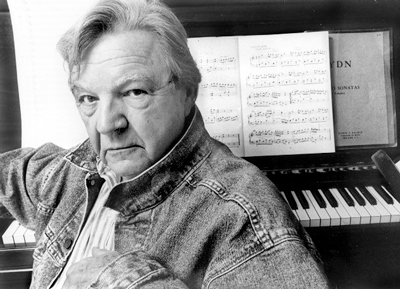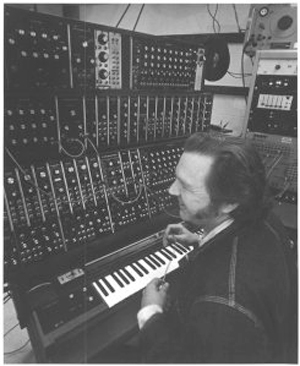by Mike Telin

On Saturday, April 29 at 7:30 pm in Ludwig Recital Hall, Kent State University’s Hugh Glauser School of Music will honor legendary composer and KSU alum Donald Erb with a “90th Birthday Concert.” The evening will also include the unveiling of the new Donald Erb Collection in KSU’s Performing Arts Library, based on material donated by the late composer’s wife, Lucille Erb. The performance is free.
“The collection includes many standard items like CD’s, scores, and parts,” Wiley said during a recent telephone conversation. “There are also original rehearsal scores with all of Don’s markings, like corrected notes and dynamic changes — he was very good about marking the changes in red. It’s fascinating to see.”
Born in Youngstown, Ohio, on January 17, 1927, Erb began studying the cornet at age six, and played jazz trumpet and arranged music for dance bands during his teen years. A graduate of Lakewood High School, he went on to serve in the Navy. He later earned a bachelor’s degree in trumpet and composition from Kent State University, a master’s from the Cleveland Institute of Music, and a doctorate from Indiana University.
Erb was the recipient of many fellowships, grants, and awards. He served as resident composer at the American Academy in Rome, artist-in-residence at the University of Wollongong in Australia, and composer-in-residence for the Dallas and St. Louis symphonies. He served as the head of the composition department at the Cleveland Institute of Music for more than 40 years.
Erb was also a 1966 Cleveland Arts Prize winner. In a biography on the Arts Prize website, longtime Plain Dealer classical music critic Wilma Salisbury writes:
Donald Erb, Cleveland’s most illustrious and controversial 20th-century composer, explored fresh sonorities and forged new paths in more than 100 boldly imaginative works. He shocked the audience in 1965 when the Cleveland Orchestra first performed his Symphony of Overtures. At the end, the composer was booed and pelted with pennies.
As prolific a composer as he was, what influence has Erb had on the music of today? “The thing that everybody talks about is electronic music, and his New York Times obituary made note of that,” Wiley said. “That was a big deal, but I think his later pieces, which didn’t emphasize electronics that much, had more impact on the music of today.”

Salisbury writes that Erb’s music:
…skillfully mixes familiar tone colors with electronic sounds and the unexpected timbres of harmonicas, kazoos, police whistles and tuned water glasses. Traditional instrumental techniques are extended with multiphonics, tongue clicking and chopsticks replacing string players’ bows. Static harmonies erupt in nervous rhythms and explosive outbursts. Zigzagging lines zoom and dive to extremes of pitch and dynamics.
“You do hear Erb’s personal style already in his Reconnaissance from 1967, which may be the first piece that combined electronic and acoustic instruments,” Wiley said. “But his masterpieces are the late, big orchestral works which are life-summarizing — they are looking toward death, but not in a negative way. Ritual Observances is one of those, and another one is Evensong. He was looking at the world in a profound, retrospective way, while writing powerful music with a big dynamic range which I think is even greater than Mahler’s in terms of soft to loud.”
Like his music, Wiley said that Erb’s personality was larger than life. Again, Salisbury writes:
During a rehearsal of the Cleveland Orchestra’s next commission, Music for a Festive Occasion (1975), the feisty composer got into an onstage altercation with music director Lorin Maazel. As a result, the ensemble ignored Erb for nearly 15 years.
“I’m not sure if all of the stories about Don are completely true, but if you knew him, you could see him doing these things,” Wiley said, laughing. “I studied with him for my doctorate, and after I returned to the area to teach at Kent, we became good friends. My wife and I had cars that, well, should not have been driven, so whenever they broke down when we were in Cleveland, we would always stay with Don. That became an ongoing joke.”
As an undergraduate at Kent State, Donald Erb studied theory with Hugh Glauser, after whom the School of Music is named. Wiley described Glauser as an old-school theory teacher who wasn’t interested in being published, or in teaching graduate students. “Hugh had a conservatory-style undergraduate approach with a strong emphasis on theory, keyboard skills, sight singing, and harmonic analysis. Don was one of his first students, and Hugh was a big influence on him. They remained friends for many years until Hugh’s passing.”
Erb continued to surprise even his closest friends up to the very end of his life. “He wanted a military funeral,” Wiley said. “We all knew that Don was in the Navy, but we never thought of him as a military person. Those of us who were around Don for so long never saw that part of him.” Donald Erb died at his home in Cleveland Heights on August 12, 2008 at the age of 81. He is buried in Lake View Cemetery.
Saturday’s program will include St. Valentine’s Day (performed by the Faculty Brass Quintet), Three Pieces for Double Bass (Brian Thomas), Three Pieces for the Enterprising Young Flutist (Diane McCloskey), Children’s Song (Aubrey Holmes and Patrick Shaughnessy, violins), and The Purple Roofed Ethical Suicide Parlor (KSU Wind Ensemble).
Published on ClevelandClassical.com April 26, 2017.
Click here for a printable copy of this article



